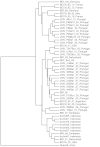Brucellosis seroprevalence in Bali cattle with reproductive failure in South Sulawesi and Brucella abortus biovar 1 genotypes in the Eastern Indonesian archipelago
- PMID: 24279343
- PMCID: PMC4222555
- DOI: 10.1186/1746-6148-9-233
Brucellosis seroprevalence in Bali cattle with reproductive failure in South Sulawesi and Brucella abortus biovar 1 genotypes in the Eastern Indonesian archipelago
Abstract
Background: Brucellosis is a major cause of infertility and reproductive failure in livestock. While cattle in the Eastern Indonesian archipelago suffers from reproductive problems information on bovine brucellosis in the region is fragmentary. The control of brucellosis requires a major and prolonged effort and confirmation of the infection by isolation with detailed knowledge of the spread of the infection is essential when planning a control program.
Results: Serological investigation of Brucella infection in beef cattle tended under extensive farming conditions revealed a high seroprevalence (19.3%; 95% CI, 17-22) in the compliment fixation tests. The results of a rapid and simple field test correlated well with the Rose Bengal test (kappa, 0.917) and indicated an acceptable sensitivity (87.5%) and specificity (98.1%) compared with the complement fixation test. Reproductive failure was reported for 39.0% of the cows with a loss of calves due to abortion or early death amounting to 19.3%. Past reproductive failure did not, however, correlate with seropositivity in the complement fixation test (RP = 1.21; P = 0.847). B. abortus biovar 1 was freshly isolated from the hygromas of two cows and together with thirty banked isolates collected since 1990 from different parts of Sulawesi and Timor eight related genotypes could be distinguished with one genotype being identical to that of an isolate (BfR91) from Switzerland. The Indonesian genotypes formed together with BfR91 and one African and one North American isolate a distinct branch on the B. abortus biovar 1 dendogram.
Conclusions: Bovine brucellosis appears to be widespread in the Eastern Indonesian archipelago and calls for urgent intervention. The fresh isolation of the pathogen together with the observed high seroprevalence demonstrates the presence and frequent exposure of cattle in the area to the pathogen. The application of a rapid and simple field test for brucellosis could be very useful for the quick screening of cattle at the pen side.
Figures


References
-
- Schmidt MK, Muslimatun S, West CE, Schultink W, Gross R, Hautvast JGAJ. Nutritional status and linear growth of indonesian infants in west java are determined more by prenatal environment than by postnatal factors. J Nutr. 2002;132:2202–2207. - PubMed
-
- Aiello SE, Mays A, editor. The Merck Veterinary Manual. 8. Whitehouse station, NJ, USA: Merck & CO., Inc; 1998.
MeSH terms
LinkOut - more resources
Full Text Sources
Other Literature Sources
Miscellaneous

